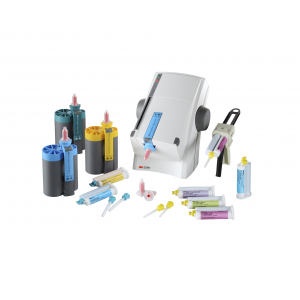How new Imprint 4 VPS Impression Material creates fast, accurate impressions [VIDEO]
Dr. Ben Miraglia has used 3M ESPE’s Imprint VPS impression materials in his practice for as long as he can remember.
Dr. Ben Miraglia has used 3M ESPE’s Imprint VPS impression materials in his practice for as long as he can remember.
He’s relied on Imprint 3 to create accurate impressions for years, and with a 95 percent success rate on first impressions, the material has done its job. But now, with the introduction of the new Imprint 4 VPS impression material, Dr. Miraglia expects to see that success rate reach 97 or 98 percent.
He’s used the newly released Imprint 4 in his practice for a few months now and, not only has he not had to do any retakes, his patients are enjoying the faster set times this new impression material offers. Depending on which impression material you use from the Imprint 4 portfolio, set times range from 2 minutes to a mere 75 seconds with the Super Quick option.
“That’s a huge advantage. There’s always been a 4 minute set time with these types of impression materials, and a 4 minute set time feels like a week to a patient,” Dr. Miraglia said. “To be able to take a VPS impression in 1 minute and 15 seconds is just incredible. Everybody benefits. It saves chair time and saves patients that inconvenience of waiting 4 minutes.”
Dr. Miraglia has used Imprint 4 to take impressions for a variety of cases, from crowns and bridges to Invisalign, and said patients have noticed a difference
in how long they’re waiting in the chair for the material to set. Patients don’t look forward to having what many see as “goop” in their mouth, so the fact that an accurate impression can be taken in half the time is something patients really appreciate.
And Imprint 4 is able to offer these faster set times with the same working time dentists are used to, making this impression material an exciting development for both dentists and their patients.
The idea behind Imprint 4
The team at 3M ESPE began working on Imprint 4 about four years ago, said Dr. Julia Farr, Scientific Affairs Manager, Global Indirect Solutions Business Team, and the idea to create an impression material with a faster set time came from their customers.
Dentists wanted a material with a faster set time to improve patient comfort as well as to reduce the chance for mistakes. They also wanted something hydrophilic in the unset state to ensure precise reproduction of details in the oral environment, which leads to accurate impressions and restorations that fit.
“You have the same working time, which is important because you need time to syringe around the teeth to capture all the details, but you can remove the material from the mouth faster,” Dr. Farr said. “When the material is setting in the mouth, distortions can occur. When the patient moves or the dentist moves, distortions can occur. With this material the time to set is much shorter, which can lead to better impressions. We have the super hydrophilicity in the unset stage, which is important to capture detail. It is more moisture tolerant to saliva and blood.”
As Global Technical Services Advisor for 3M ESPE Prosthodontic Business Team, Mack Rivas is part of that team that talks with dentists and assistants to get a feel for what they really want and need in a product (in this case, impression materials).
Once Rivas and his group gathered this information, or voice of customer, for what became Imprint 4, they sent it on to the Research and Development department as well as the company’s engineers, who from there began thinking about how to develop a product that would meet those needs.
No matter the product, input from dental professionals is key to product development at 3M ESPE, from the very beginning until the product is released, Rivas said.
“3M ESPE’s new product introduction process is a very structured way of product development and commercialization,” said Dr. Peter Osswald, who is part of the R&D team at 3M ESPE. “This process includes several reviews to demonstrate performance, safety, regulatory requirements, manufacturability and commercialization aspects of a new product.
The customer is always in the center of our products. In the beginning, we define the basic product features based on the customer feedback and develop prototype formulations, which meet exactly these requirements in lab tests.
After biocompatibility testing and regulatory approval, the customer feedback obtained from application tests in several countries is the key decision factor for the start of commercialization.”
And when it comes to new product development at 3M ESPE, there are several departments involved, from R&D to production to quality management to safety to marketing. New product development at 3M ESPE is an intense process that involves a variety of players.
The process can take years, but once the product is ready for market, the team members involved are confident the product will be a success, and is something that will help their customers practice better dentistry. And that’s exactly how they feel about Imprint 4.
“The Imprint 4 portfolio consists of various materials offering different setting times and viscosities to satisfy all customer preferences and requirements,” Dr. Osswald said. “We have only been able to succeed in developing all of these materials in time by a highly motivated team and with all the individuals acting together as one unit.”
Why now
In recent years, innovation in impressioning has been mainly attributed to digital impression systems, Dr. Osswald said, something 3M has been involved in with the development of the 3M True Definition Scanner.
Even so, many dentists still use VPS material to take impressions, and that’s an area that hasn’t seen much of an update, said Mark Cotton, Marketing Manager, Impression Materials. That, combined with the fact they knew dentists wanted a material with faster setting times, drove the team at 3M ESPE to create Imprint 4.
“There hasn’t been a wow factor in the VPS impression material business for a long time. Imprint 4 brings the wow factor with the blazing fast intraoral set time while maintaining adequate working time,” Cotton said.
“Doctors are always looking for ways to decrease procedure time and increase patient comfort. Imprint 4 accomplishes both of these issues. More importantly, this product benefits patients by reducing the time they have to sit in the chair waiting for an impression to be completed. Nothing good can come from having an impression take longer in the mouth.”
How it works
The team at 3M ESPE knew dentists and patients wanted an impression material with a faster set time, they just needed to find a way to make it happen. After screening different technologies and approaches, they found adding a self-warming mechanism to accelerate the VPS setting reaction was the best way to achieve a shortened setting time without compromising the working time, said Rüdiger Hampe, R&D Services, Customer Integration.
In this special case, Dr. Osswald said they knew they only needed to accelerate the second half of the setting reaction and that the first half-the working time-should remain unaffected. They made this happen by using an additive that has a tailored reactivity, enabling the self-warming reaction only in the last part of the setting reaction.
“Imprint 4 incorporates new patent pending technology that makes the material warm from within,” Cotton said. “Once the material is in the mouth, the material will actively warm up to body temperature (98.6). The warming of the material allows the intraoral setting time to be reduced. The material will never get warmer than 98.6. The active-self warming allows Imprint 4 to have a faster set time, while also increasing patient comfort and decreasing procedure time.”
Putting Imprint 4 to the test
Before a new product can be brought to market, it needs to be tested in the field. 3M ESPE performed clinical application testing with 300 dentists in the U.S. and Europe, Dr. Farr said. Each dentist received prototype material, which they used for six weeks.
These dentists created more than 3,000 impressions with the material and each one sent feedback on what they liked about the product or how it could be improved.
“This is a very important part because, first of all, it gives you confidence that the product performs how it should. We want to make sure it works for the dentists and that they can handle the product in the right way, and that they like the product,” Dr. Farr said. “Then we can go back and make changes if needed.”
The feedback
The clinicians who have had a chance to use Imprint 4 in their practice, like Dr. Miraglia, love the faster set time and the accurate impressions, Rivas said. It makes impression taking faster, easier and more predictable, and that’s something every dentist wants.
“The overall satisfaction rate was very high. The short intraoral setting time, combined with adequate working time, was mentioned as one of the most significant application benefits,” Hampe said. “Impression accuracy, including high detail reproduction, was another reason for dentists’ overall satisfaction with Imprint 4. As a result of satisfaction, 89% of the testers would recommend Imprint 4 VPS impression material to their colleagues.”
Dentists are also pleased with how easy the margins can be read, Dr. Farr said. The new, fresh colors offer a great contrast that makes this possible. Dental lab professionals have also taken note, and are thrilled with the crisp, accurate impressions they’re receiving.
Why you should give it a try
There are no new techniques or a learning curve with Imprint 4-it works the same way as the impression material you’re using now, Hampe said. But this new impression material offers a faster setting time and more accurate impressions for better fitting restorations, both features that will make impression taking easier, quicker and more successful. It makes the impression-taking procedure less stressful and more comfortable for patients, especially for patients who are gaggers.
These are all benefits patients will notice and talk about, and that can only mean good things for your practice.
“The general procedure of impression taking does not change with Imprint 4 as the portfolio offers impression materials for all techniques as well as different viscosities and setting versions,” Dr. Osswald said. “But impression taking with Imprint 4 makes the procedure easier, faster and more convenient for the dentist and the patient.”


